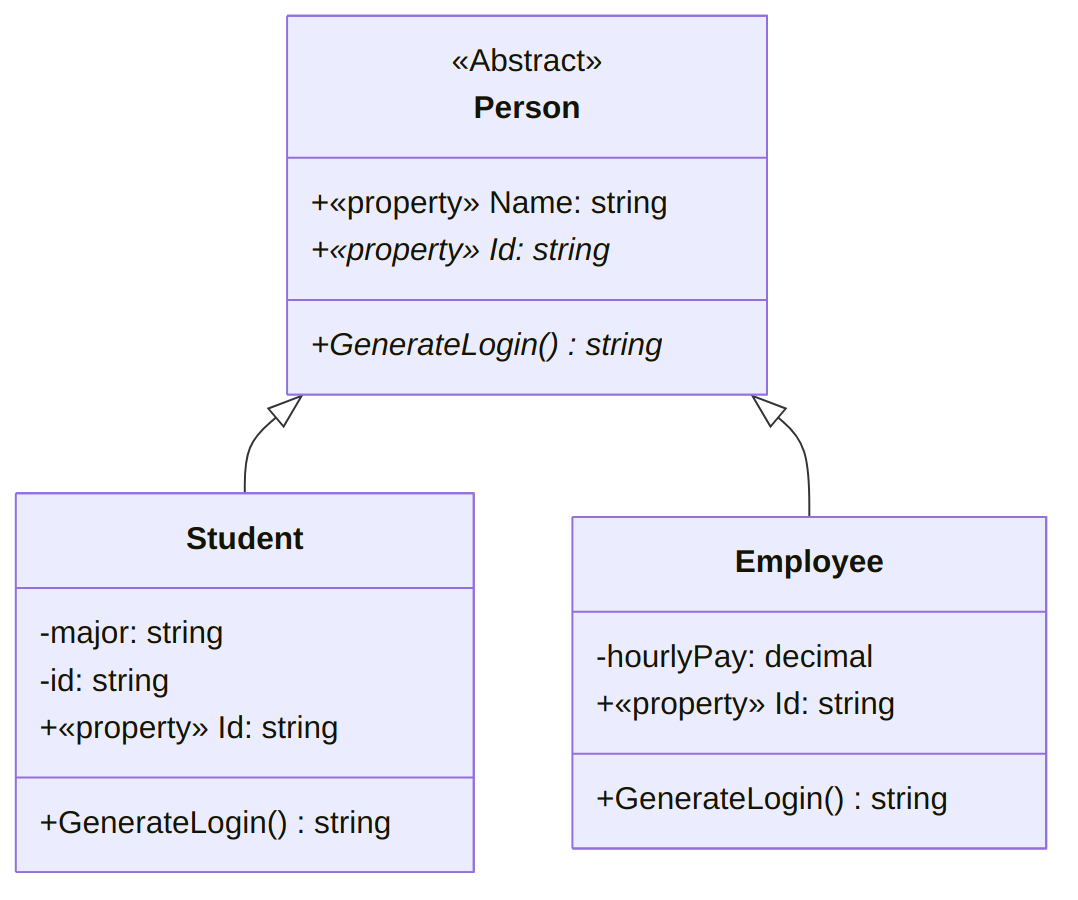Motivation
Consider the following situation:
- We want to implement a class for students, and one for employees.
- We realize that those class overlap heavily: they both need properties for an id, a name, an emergency phone number, an address, etc., identical methods to e.g., implement an automated alert system, etc.
- However, they do not overlap perfectly: for example, students will have a major but employees won’t, and employee will have an hourly wage but students won’t. Also, some checks will be different: while both students and employees will have an id, the former will always have to start with the letter ‘S’, but the latter won’t have any requirement.
- So we really do need two different classes, but would like for them both to inherit a “Person” class that implements all the overlapping properties, attributes and methods.
- But we do not want persons “objects” to be created: a “person” in isolation does not make sense in our model, we only want to implement students or employees, not “persons”.
The mechanism used to obtain this behavior (being able to inherit from a
class while disallowing instantiating it) is achieved using the
abstract keyword.
Example
Consider a (shortened) version of the example above. We start by
implementing an abstract Person class:
abstract class Person
{
public string Name { get; set; }
public abstract string Id { get; set; }
}Note that the Id property is also marked as abstract: this means
that the derived class will have to re-implement this property’s setter
and getter. Then, we can implement the Student and Employee classes
by inheriting from the Person class:
using System;
class Student : Person
{
private string major;
private string id;
public override string Id
{
set
{
if (value[0] != 'S')
throw new ArgumentException(
"A student ID must start with an 'S'."
);
else
id = value;
}
get { return id; }
}
}using System;
class Employee : Person
{
private decimal hourlyPay;
public override string Id { get; set; }
}Note that the Employee does not need to add an attribute for Id
since it is using automatic properties, but that Student does.
Using this code, the statement
Person test = new Person();would return the error message “Cannot create an instance of the abstract type or interface ‘Person’“.
Furthermore, the following exemplifies the expected behavior:
using System;
class Program
{
static void Main()
{
// Person test = new Person();
// Cannot create an instance of the abstract type or interface 'Person'
Employee Harley = new Employee();
Harley.Id = "E8190";
Student Morgan = new Student();
try
{
Morgan.Id = "E8194";
}
catch
{
Console.WriteLine(
"We cannot set the Id of a student to a string not starting with 'S'!"
);
}
Morgan.Id = "S8194";
}
}The statement Morgan.Id = "E8194"; will raise exception, but
Morgan.Id = "S8194"; will execute without throwing an error.
Additional Details: Abstract Properties and Methods
-
As we’ve seen above with the
Idproperty, not only classes can be marked as abstract. -
For abstract properties, using
{get; set;}, only{get;}or only{set;}indicates if the derived class needs to implement both a setter and a getter, or only one of them. -
In addition to properties, methods can also be marked as abstract: in that case, their body need to be absent (not simply empty: missing).
-
For example, the
Personclass could also containpublic abstract string GenerateLogin();to “force” any derived class to implement a
GenerateLoginmethod that does not take any parameter and returns astring. The derived classes would need to implement a method that overrides thePerson’sGenerateLoginmethod1:public override string GenerateLogin(){ // Insert method body. }Note that an
abstractmethod is implicitly avirtualmethod, as it must be overridden. Hence, no need to specify thevirtualmodifier.
-
-
However, abstract attributes are not allowed.
UML Class Diagram Representation
- An abstract class is represented by as a class with its name prefixed
by
<<Abstract>>,«Abstract», or with its name displayed in italics, - An abstract method or property is represented as a usual, except that it is displayed in italics.
- Since, for example,
Person’sGenerateLogin()method is to be overridden (it has to be, actually, since it is abstract), it is indicated again in theStudentandEmployeeclasses: this indicates that those method override the one they have inherited from thePersonclass.

Footnotes
-
Which should have the same signature and return type. ↩